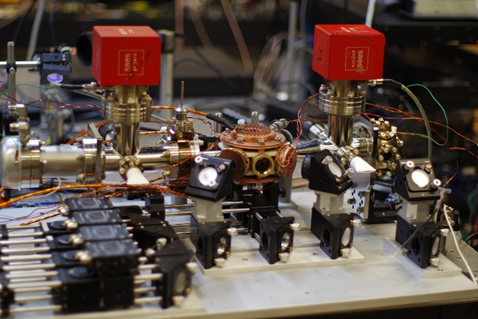Summary
Developing advanced optical clocks that can operate beyond the lab unlocks new applications in science, technology, and quantum sensing and metrology.
Description

Atom chamber for the NIST portable optical lattice clock.
Exploiting their very high precision, atomic clocks today are used extensively in demanding timekeeping applications. These include a variety of navigation, communication, and remote sensing and imaging applications. The very best atomic clocks today, optical clocks, are among the most precise measurement devices of any kind. For example, the NIST ytterbium optical lattice clock can make frequency or time measurements with a staggering 18 digits of precision. This extreme precision can be leveraged for tests of fundamental physics, like the search for time-varying fundamental constants or dark matter. If these advanced laboratory clocks can be taken beyond the lab, their precision can be deployed for mapping earth’s gravity, studying geophysical processes, or testing general relativity. Portable optical clocks can also advance the global effort towards re-defining and modernizing our base unit of time, the SI second. Towards all of these goals, we have been developing a portable optical lattice clock to deliver state-of-the-art optical clock performance beyond the lab. Our current efforts include implementing new technologies and quantum tools to advance technology readiness of the portable clock, making detailed characterizations of the cold-atom timekeeper both in and out of the lab, and making a novel, ultra-stable cavity-stabilized laser for the portable clock. We will first be deploying the portable clock for next-generation geodesy measurements, as well as optical clock comparisons towards re-defining the second.
Relevant Publications
R. J. Fasano et al., “Characterization and Suppression of Background Light Shifts in an Optical Lattice Clock,” Physical Review Applied 15 044016 (2021).
BACON collaboration et al., “Frequency ratio measurements at 18-digit Accuracy using an optical clock network,” Nature 591 564 (2021).
M. Bodine et al., “Optical atomic clock comparison through turbulent air,” Phys. Rev. Research 2 033395 (2020).
W. McGrew et al., “Atomic clock performance enabling geodesy below the centimeter level,” Nature 564 87 (2018).
A. D. Ludlow, “An optical clock to go,” Nature Physics 14 431 (2018).
A. D. Ludlow et al., “Optical Atomic Clocks,” Rev. Mod. Phys 87 637-701 (2015).

